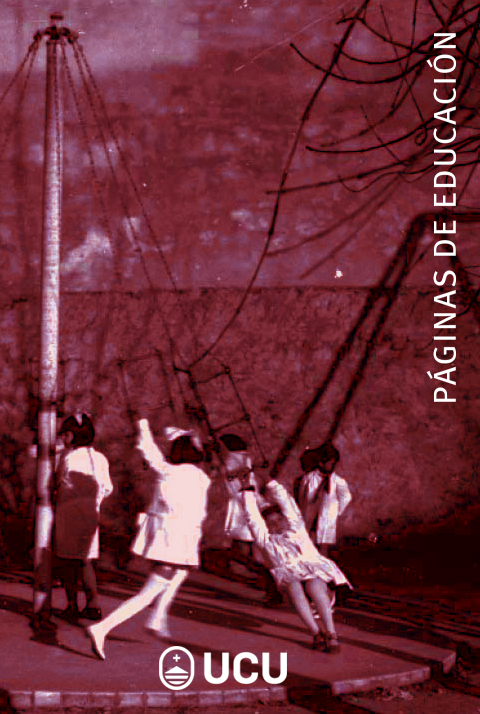Conflict Resolution in Adolescence: Application of a Questionnaire in Co-Educational Schools and Schools Differenced by Sex in Spain
DOI:
https://doi.org/10.22235/pe.v12i2.1833Keywords:
Social Behavior, Conflict, Adolescence, Gender, Classroom arrangementAbstract
The purpose of this research is to analyze the different styles of conflict resolution found in adolescent students in Spain and to see if there are significant differences between men and women, also taking into account the type of center they attend (mixed or differentiated by sex). For this purpose, a sample of 816 students from 12 Spanish schools was defined and a questionnaire based on the Thomas-Kilmann Conflict Mode Instrument (TKI), adapted and validated for adolescents, was applied. The results confirm differences between sexes, already identified in other investigations, and for both sexes, in the differentiated school, higher scores appear in the collaborative style in comparison with male and female students attending a mixed school. No significant differences were found for the other styles of conflict resolution.
Downloads
References
Althof, W., y Berkowitz, M. W. (2006). Moral education and character education: their relationship and roles in citizenship education. Journal of Moral Education, 35(4), 495-518. https://doi.org/10.1080/03057240601012204
Baker, J. M., Liu, N., Cui, X., Vrticka, P., Saggar, M., Hadi Hosseini, S. M., y Reiss, A. L. (2016). Sex differences in neural and behavioral signatures of cooperation revealed by fNIRS hyperscanning. Scientific Reports, 6. https://doi.org/10.1038/srep26492
Berk, L. E. (2002). Infants, children and adolescents. Boston, MA: Allyn & Bacon.
Björkqvista, K., Östermana, K., y Kaukiainen, A. (2000). Social intelligence − empathy = aggression? Aggression and Violent Behavior, 5(2), 191–200. https://doi.org/10.1016/S1359-1789(98)00029-9
Boqué, M. C., Pañellas, M., Alguacil, M., y García, L. (2014). La cultura de paz en la educación para la ciudadanía y los derechos humanos en los libros de texto de educación primaria. Perfiles Educativos, 36(146), 80-97.
Brahnam, S. D., Margavio, T. M., Hignite, M. A., Barrier, T. B., y Chin, J. M. (2005). A gender-based categorization for conflict resolution. Journal of Management Development, 24(3), 197-208. https://doi.org/10.1108/02621710510584026
Caballo, V. (1993). Manual de evaluación y entrenamiento de las habilidades sociales. Madrid, España: Siglo XXI.
Camps J., y Vidal, E. (2015). Marte y Venus en el aula: las percepciones del alumnado sobre los efectos psicosociales de la escolarización mixta y diferenciada. Revista Española de Pedagogía, 260, 53-71.
Card, N. A., Stucky, B. D., Sawalani, G. M., y Litte, T. D. (2008). Direct and Indirect Aggression During Childhood and Adolescence: A Meta-Analytic Review of Gender Differences, Intercorrelations, and Relations to Maladjustment. Child Development, 79(5), 1185-1229. https://doi.org/10.1111/j.1467-8624.2008.01184.x
Casey, E., Carlson, J., Two Bulls, S., y Yager, A. (2016). Gender Transformative Approaches to Engaging Men in Gender-Based Violence Prevention: A Review and Conceptual Model. Trauma, Violence, & Abuse, 19(2), 231–246. https://doi.org/10.1177/1524838016650191
Commission of the European Communities. (2008). Improving competences for the 21st Century: An Agenda for European Cooperation on Schools. Recuperado de https://eur-lex.europa.eu/LexUriServ/LexUriServ.do?uri=COM:2008:0425:FIN:EN:PDF
Deutsch, M. (1973). The Resolution of Conflict: Constructive and Destructive Processes. New Haven, CT: Yale University Press.
Deutsch, M. (2015). Cooperation, Competition, and Conflict. En P. Coleman y M. Deutsch, Morton Deutsch: A Pioneer in Developing Peace Psychology (pp. 47-70). Nueva York, NY: Springer International Publishing.
De Wied, M., Branje, S. J. T., y Meeus, W. H. J. (2007). Empathy and conflict resolution in friendship relations among adolescents. Aggressive Behavior, 33, 48-55. https://doi.org/10.1002/ab.20166
Díaz-Pintos, G. (2007). Resolución de conflictos y educación. En Fundación Europea Sociedad y Educación (Ed.), Nuevos retos para convivir en las aulas: construyendo la escuela cívica (pp. 29-36). Madrid, España: Fundación Europea Sociedad y Educación.
Eagly, A. H., y Johnson, B. T. (1990). Gender and leadership style: a meta-analysis. Psychological Bulletin, 108(2), 233-256.
Galvis, R. I. (2014). Las neuronas espejo y el desarrollo de la empatía frente a la agresión y el conflicto en la escuela. Praxis Pedagógica, 15, 43-53.
Garaigordobil, M., y Maganto, C. (2011). Empatía y resolución de conflictos durante la infancia y la adolescencia. Revista Latinoamericana de Psicología, 43(2), 255-266.
Gilligan, C. (1982). In a Different Voice. Cambridge, MA: Harvard University Press.
Hakvoort, I. (2010). The conflict pyramid: a holistic approach to structuring conflict resolution in schools. Journal of Peace Education, 7, 157–169. https://doi.org/10.1080/17400201.2010.498997
Hernández-Serrano, O., Espada, J. P., y Guillén-Riquelme, A. (2016). Relación entre conducta prosocial, resolución de problemas y consumo de drogas en adolescentes. Anales de Psicología, 32(2), 609-616. https://doi.org/10.6018/analesps.32.2.204941
James, V. H., y Owens, L. D. (2004). Peer Victimisation and Conflict Resolution Among Adolescent Girls in a Single-sex South Australian School. International Education Journal, 5(1), 37-49.
Johnson, C. A., Thompson, R. C., y Anderson, M. G. (2014). Technical Brief for the Thomas-Kilmann conflict mode instrument-Global research project for translated TKI assessments. Recuperado de https://kilmanndiagnostics.com/wp-content/uploads/2018/04/TKI_TranslationsStudy.pdf
Kagan, J., y Herschkowitz, N. (2005). A young mind in a growing brain. Mahwah, NJ: Erlbaum.
Kilmann, R. H., y Thomas, K.W. (1977). Developing a forced-choice measure of conflict-handling behavior: The MODE instrument. Educational and Psychological Measurement, 37, 309-325. https://doi.org/10.1177/001316447703700204
Koepke, M. F., y Harkins, D. A. (2008). Conflict in the classroom: gender differences in the teacher child relationships. Early Education & Development, 19(6), 843-864.
León, A. C. (2010). Una aproximación analítica al feminismo de género (Tesis doctoral). Universitat Autònoma de Barcelona, España. Recuperado de http://www.tesisenred.net/bitstream/handle/10803/32084/alm1de1.pdf?sequence=1
Luengo, B. P., Pastorelli, C., Eisenberg, N., Zuffianò, A., y Caprara, G. V. (2013). The Development of Prosociality from Adolescence to Early Adulthood: The Role of Effortful Control. Journal of Personality, 81(3), 302-312. https://doi.org/10.1111/jopy.12001
Maccoby, E. E. (2003). The Two Sexes. Cambridge, MA: Harvard University Press.
Mael, F., Alonso, A., Gibson, D., Smith, M., y Rogers, K. (2005). Single-Sex Versus Coeducational Schooling: A Systematic Review. Recuperado de https://www2.ed.gov/rschstat/eval/other/single-sex/single-sex.pdf
Ministerio de Educación y Ciencia. (2006). Real Decreto 1513/2006, de 7 de diciembre, por el que se establecen las enseñanzas mínimas de la Educación primaria. Boletín Oficial del Estado. Recuperado de https://www.boe.es/diario_boe/txt.php?id=BOE-A-2006-21409
Mitsopoulou, E., y Giovazolias, T. (2015). Personality traits, empathy and bullying behavior: A meta-analytic approach. Aggression and Violent Behaviour, 21, 61-72. https://doi.org/10.1016/j.avb.2015.01.007
Moreno, J. M., y Luengo, F. (2007). Construir ciudadanía y prevenir conflictos. La elaboración de planes de convivencia en los centros. Madrid, España: Wolters Kluwer.
Pahlke, E., Hyde, J. S., y Allison, C. M. (2014). The Effects of Single-Sex Compared With Coeducational Schooling on Students’ Performance and Attitudes: A Meta-Analysis. Psychological Bulletin, 140(4), 1042-1072. https://doi.org/10.1037/a0035740
Pérez-Juste, R. (2007). La escuela como espacio de convivencia e integración cultural. En Fundación Europea Sociedad y Educación (Ed.), Nuevos retos para convivir en las aulas: construyendo la escuela cívica (pp. 39-65). Madrid, España: Fundación Europea Sociedad y Educación.
Perrenoud, P. (2004). Diez nuevas competencias para enseñar. Barcelona, España: Graó.
Rahim, M. A. (1983). A Measure of Styles of Handling Interpersonal Conflict. Academy of Management Journal, 26(2), 368-376. https://doi.org/10.2307/255985
Rahim, M. A. (2001). Managing conflict in organizations (3a Ed.). Westport, CT: Quorum Books.
Rodrigo, M. J., García, M., Máiquez, M. L., Rodríguez, B. y Padrón, I. (2008). Estrategias y metas en la resolución de conflictos cotidianos entre adolescentes, padres y madres. Infancia y Aprendizaje, 31(3), 347-362.
Saiti, A. (2015). Conflicts in schools, conflict management styles and the role of the school leader. A study of Greek primary school educators. Educational Management Administration Leadership, 43(4), 582-609. https://doi.org/10.1177/1741143214523007
Soriano, E. (2006). Competencias ciudadanas en el alumnado de segundo ciclo de educación secundaria obligatoria de Almería. Revista de Investigación Educativa, 24(1), 119-146.
Tabachnick, B.G., y Fidell, L.S. (2001). Using Multivariate Analysis. Boston, MA: Allyn and Bacon.
Thomas, K. W., y Kilmann, R. H. (1978). Comparison of four instruments measuring conflict behavior. Psychological Reports, 42, 1139-1145.
Thomas, K. W., y Kilmann, R. H. (2007). Thomas-Kilmann Conflict Mode Instrument. Mountain view, CA: CPP, Inc. Trabajo original publicado en 1974
Thomas, K. W., Thomas, G. F., y Schaubhut, N. (2008). Conflict styles of men and women at six organization levels. The international Journal of Conflict Management, 19, 148-166.
Unión Europea. (2006). Recomendación del Parlamento Europeo y del Consejo de 18 de diciembre de 2006 sobre las competencias clave para el aprendizaje permanente. Diario Oficial de la Unión Europea. Recuperado de http://eur-lex.europa.eu/legal-content/ES/TXT/?uri=celex:32006H0962
Van der Graaff, J., Branje, S., De Wied, M., Hawk, S., y Van Lier, P. (2014). Perspective Taking and Empathic Concern in Adolescence: Gender Differences in Developmental Changes. Developmental Psychology, 50(3), 881-888.
Vidal, E. (2015). Un feminismo del siglo XXI. Pamplona, España: EUNSA.
Villamediana, J., Donado, A., y Zerpa, C. E. (2015). Estilos de manejo de conflictos, inteligencia emocional y desarrollo moral. Dimensión Empresarial, 13(1), 73-94. https://doi.org/10.15665/rde.v13i1.339
Volkema, R. J., y Bergmann, T. J. (1995). Conflict styles as indicators of behavioral patterns in interpersonal conflicts. Journal of Social Psychology, 135, 5-15.















